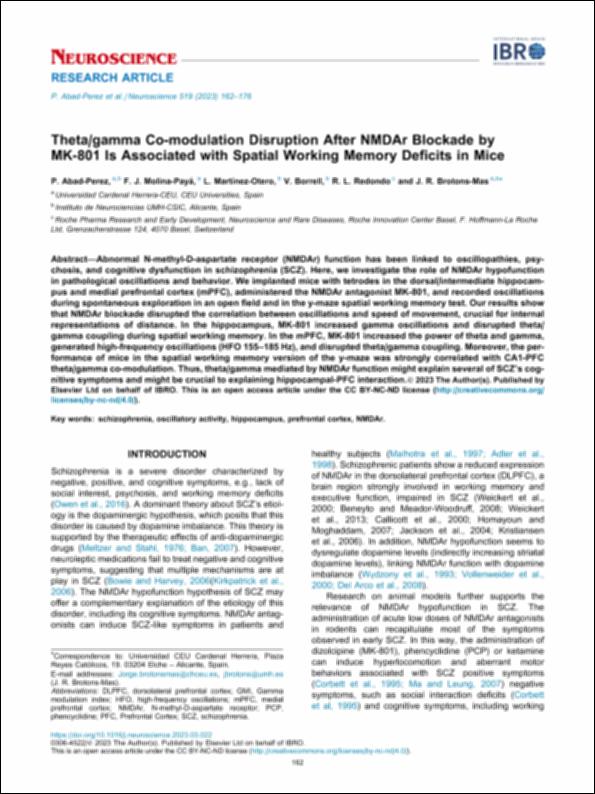Please use this identifier to cite or link to this item:
http://hdl.handle.net/10637/14925Theta/gamma co-modulation disruption after NMDAr blockade by MK-801 Is associated with spatial working memory deficits in mice
| Title: | Theta/gamma co-modulation disruption after NMDAr blockade by MK-801 Is associated with spatial working memory deficits in mice |
| Authors : | Abad Pérez, Pablo Molina Payá, Francisco Javier Martínez Otero, Luis Borrell, Víctor Redondo, Roger L. Brotons Mas, Jorge |
| Keywords: | Psicosis; Psychoses; Enfermedad mental; Mental diseases; Psicopatología; Psychopathology |
| Publisher: | Elsevier |
| Citation: | Abad-Perez, P., Molina-Payá, F.J., Martínez-Otero, L., Borrell, V., Redondo, R.L. & Brotons-Mas, J.R. (2023). Theta/gamma co-modulation disruption after NMDAr blockade by MK-801 Is associated with spatial working memory deficits in mice. Neuroscience, vol. 519 (may.), pp. 162–176. DOI: https://doi.org/10.1016/j.neuroscience.2023.03.022 |
| Abstract: | Abnormal N-methyl-D-aspartate receptor (NMDAr) function has been linked to oscillopathies, psychosis, and cognitive dysfunction in schizophrenia (SCZ). Here, we investigate the role of NMDAr hypofunction in pathological oscillations and behavior. We implanted mice with tetrodes in the dorsal/intermediate hippocampus and medial prefrontal cortex (mPFC), administered the NMDAr antagonist MK-801, and recorded oscillations during spontaneous exploration in an open field and in the y-maze spatial working memory test. Our results show that NMDAr blockade disrupted the correlation between oscillations and speed of movement, crucial for internal representations of distance. In the hippocampus, MK-801 increased gamma oscillations and disrupted theta/gamma coupling during spatial working memory. In the mPFC, MK-801 increased the power of theta and gamma, generated high-frequency oscillations (HFO 155–185 Hz), and disrupted theta/gamma coupling. Moreover, the performance of mice in the spatial working memory version of the y-maze was strongly correlated with CA1-PFC theta/gamma co-modulation. Thus, theta/gamma mediated by NMDAr function might explain several of SCZ’s cognitive symptoms and might be crucial to explaining hippocampal-PFC interaction. |
| URI: | http://hdl.handle.net/10637/14925 |
| Rights : | Open Access http://creativecommons.org/licenses/by-nc-nd/4.0/deed.es |
| ISSN: | 0306-4522 |
| Issue Date: | 21-May-2023 |
| Center : | Universidad Cardenal Herrera-CEU |
| Appears in Collections: | Dpto. Medicina y Cirugía |
Items in DSpace are protected by copyright, with all rights reserved, unless otherwise indicated.


